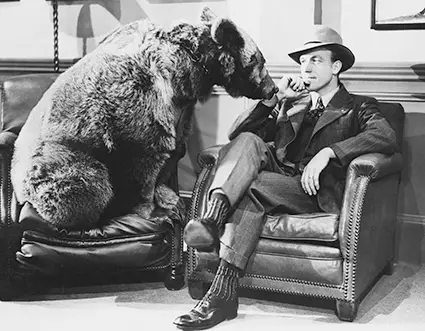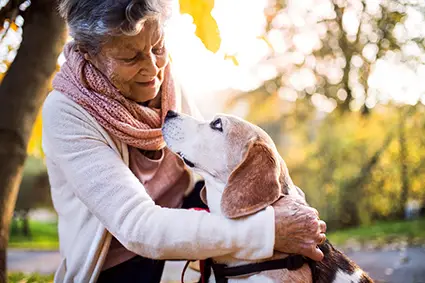Many people don’t know how beneficial pet therapy visits for seniors are.

According to a study in the Proceedings of the National Academy of Sciences, adults aged 52 and older have a higher risk of mortality due to both social isolation and loneliness. Pet therapy visits for seniors can help combat that statistic, and aid in curing senior depression.
In this article, we will cover the extensive benefits of pet therapy visits for seniors.
Animals and People: An Ancient Relationship
For all of recorded history, the relationship between human beings and their pets has been crucial. Cats can be found frequently in ancient Egyptian art. In Homer’s The Odyssey, written in the 8th century, BC, there is a poignant moment when Odysseus returns home to find his dog Argos, who had been waiting loyally for him during his twenty year journey.

This ancient relationship continues today. The family dog greets you at the door and suddenly you are the most important person in the world. The wagging tail tells you that you are necessary and you are good and you are loved. A cat snuggles up against you, demanding your attention as if to say, “I am here. Notice me. You are not alone.” The deep rhythmic sighs of a sleeping animal act as a natural white noise machine, bringing a sense of calm to a space. If the dog can sleep, then everything is safe right now.
The benefits of pet therapy and other interactions with animals have been experienced by many and are well-documented. Pet owners are often helped in their physical, mental and social well-being. Dogs need to be walked, leading to better cardiovascular health for the owner. Animals need to be fed and cared for, giving owners a sense of purpose and establishing daily routines.
The Benefit of Animals for Senior Citizens
There are many benefits to pet therapy for seniors, especially seniors who are dealing with loneliness and anxiety:
- Calm animals have a calming effect. Engaging with an animal, such as a therapy dog, reduces levels of cortisol, a hormone the body produces in response to stress. It is also increases levels of serotonin, a hormone that influences mood. Higher levels are associated with feeling happy, calm and focused.

- Animals give mental stimulation. Those involved with seniors can describe how a lack of stimulation can lead to a decrease in mental sharpness. A visit from an animal can stimulate memories as the senior compares the animal to past pets. It is also natural for seniors to talk with an animal companion during a visit, strengthening conversation skills
- Animals can increase social interaction. Live-in pets for seniors can lead to social connections in a neighborhood if the pet needs to be brought outside regularly. Pet visits in home for seniors involve not only a pet therapy animal but also a human handler with whom the senior can engage in conversation.
The Challenge of Pet Ownership for Seniors
The ownership of pets for seniors, especially for those living at home, can be a challenge. It can be tempting for family members to purchase a pet, noting the physical and mental benefits mentioned above. As difficult as it may be to discuss, it is important to consider whether a senior is physically and mentally able to care for a pet. If a senior has balance issues, walking a dog can be difficult or dangerous. If a senior has short-term memory loss, it can lead to overfeeding or underfeeding of the animal as well as problems if the pet ever needs medication of its own.
Pet Therapy as an Option
If a full-time pet for a senior is not appropriate, another possibility is in-home pet therapy for seniors.

Many people are familiar with therapy animals that visit senior care facilities. These animals are different from service animals that are trained to aid an individual with specific tasks, such as a seeing eye dog. Instead, therapy animals are animals that are selected for having a calm temperament and excellent obedience. Often such animals will have been exposed ahead of time to the situations and equipment that are common to senior care facilities so that they will not be surprised or skittish. As in other home therapy models, the animal and handler come regularly for one-on-one visits.
Finding In-Home Pet Visitation Services
While it is still most common to find these animals and handlers volunteering at larger facilities, there are a growing number of services that provide pet visits in home for seniors.

You will want to do a little research to find a service that fits your needs, especially paying attention to the certification standards for animals and handlers.
Some resources that may be helpful in your search are:
- Local nursing homes, assisted living facilities and hospitals. Many of these larger organizations already have a relationship with therapy animal groups or individual volunteers. They may be willing to put you in contact with their resources.
- Departments of elder services and social services. Your local government offices may have lists of non-profit groups that provide animal therapy.
- A local senior center. This organization is often related to a department of elder or senior services, but the facility itself may already have a relationship with pet therapy volunteers or groups.
- Therapy animal certification organizations. The bodies that certify therapy animals and their handlers may be able to share the names of people and groups who are actively providing therapy in your area. They may also have recommendations about individual animals that would best suit your senior’s situation.
A Therapy Visit: A Moment of Joy
The benefits of pet therapy are many. A visit from a therapy animal can brighten anyone’s day. For seniors especially, such animals can provide a moment of joyful connection. In home animal visits can be an important part of providing a senior in your life a sense of calm, care and companionship.



